7 lessons from Great Dixter, a garden that supports wildlife and looks gorgeous
Do you want to support wildlife in your garden – but you don’t want a ‘wild’ looking garden? You’d like beautiful borders and gorgeous pots? Even, perhaps, a short neat lawn?
The gardening world is getting more polarised between the re-wilders and those who want their outdoor space to look like traditional gardens.
But at Great Dixter, one of the most influential gardens in the world, head gardener Fergus Garrett believes that we can support wildlife by having lots of different sorts of gardens. There doesn’t need to be an ‘either/or’ situation.
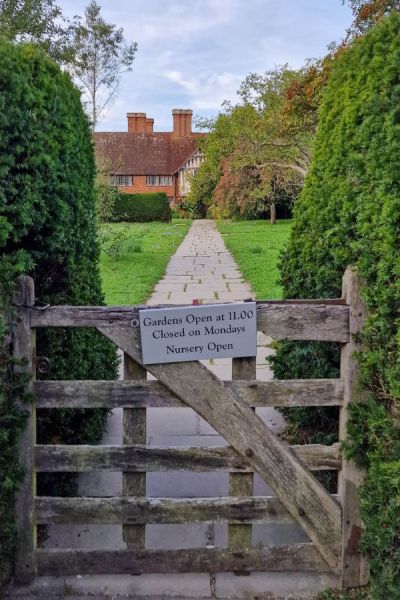
Great Dixter is open to the public March-October, 11am-5pm. It’s also an educational centre, with workshops, fairs and lectures as well as a plant nursery, shop and a cafe.
Great Dixter has a famous Long Border planted up with a wide range of herbaceous perennials. There are both long and short lawns plus topiary, hedging, paths, buildings, terraces and ponds.
Like all gardens, it has its working areas and neglected areas, too.
It stands in countryside, framed in the rolling countryside of the Sussex Weald, surrounded by woodland and meadows.
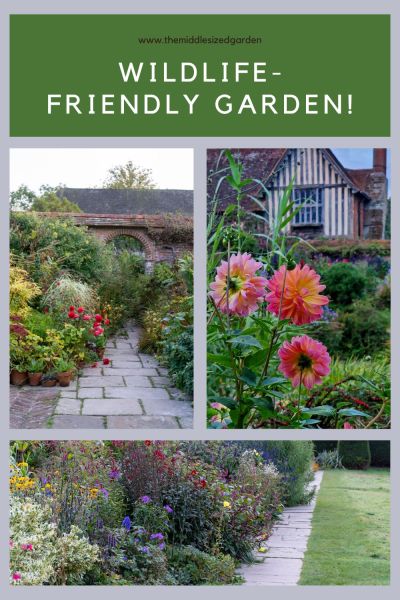
Great Dixter – a garden that looks gorgeous – and biodiversity audits show that wildlife is very well supported throughout the estate. It shows the importance of a mosaic of habitats – long and short grass, flower borders and wilder areas, shrubs and trees and so on.
What is a biodiversity audit?
A biodiversity audit is a scientific study which counts and measures the wildlife and the ecology of an area.
Great Dixter has been running biodiversity audits for several years. They cover the gardens plus the surrounding fields, meadows and woodlands. The audits also include the little things that we may not notice – the lichens, funghi, algae and mosses.
Fergus originally thought that the meadows and woodland would be the most wildlife-friendly and biodiverse part of the estate.
So he was surprised to discover that the two highly managed areas with the most garden flowers – the Barn Garden and the Long Border – had the highest number of species.
However, he points out that this doesn’t mean they’re ‘better’ than the meadows and the woodland. That’s because each area feeds into others. The flowers in the garden borders provide food. And the trees in the woodlands can provide shelter, for example.
The results of the Great Dixter biodiversity audits showed that it’s a healthy ecological environment that supports wildlife well. Fergus asked the ecologists what they could do better. ‘They said there wasn’t anything that needed improvement. We should just go on doing what we are doing.’
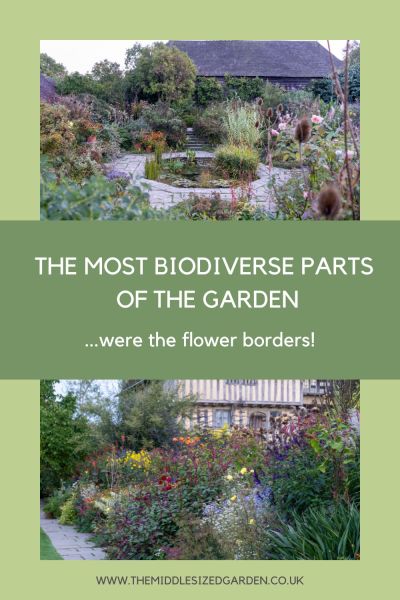
The biodiversity audit found the highest number of species in the flower-filled borders of the Long Border and the Barn Garden. The Barn Garden also has a pond, and lots of ‘nooks & crannies’ and it has the highest number of key species on the whole estate.
Listen to the biodiversity at Great Dixter (it’s fascinating!)
From 2024, you’ll be able to listen to some of that wildlife, too. A company called Sound Matters has recorded the sounds of life at Great Dixter. This ranges from the people to the birds and even the sounds of the insects and invertebrates munching away in a ‘habitat pile’ of logs. There’s a short extract of this (it’s amazing!) in my video interview with Fergus here. Go to 16.38 minutes if you just want to hear the sounds of the habitat pile.
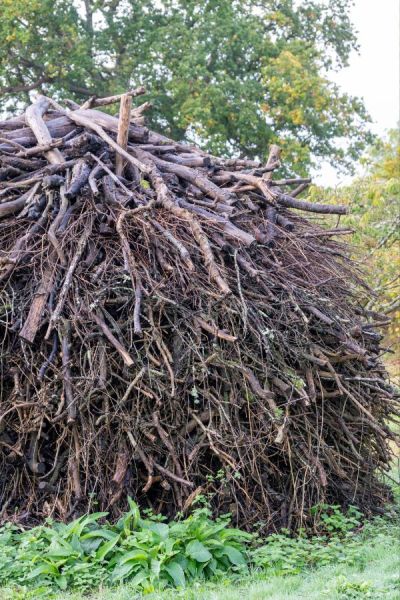
The habitat pile at Great Dixter. You can listen to the sound of the wood-borer beetles and other creatures that eat detritus munching away in the Sound Matters project, coming to Great Dixter in 2024. And here’s a 37 second preview of the munching inside this log pile here!
Different kinds of urban garden can be wildlife-friendly in different ways
Fergus says the diversity is the key to increasing bio-diversity.
He believes that urban gardens can mimic the countryside if they are different from each other and follow a few basic principles.
‘We have short lawns, some people in town will have short lawns. We have longer meadow grass and some gardens or areas in a town have longer grass, but it doesn’t need to be all long,’ he says.
‘We have borders at Great Dixter – town gardens have borders. We have neglected parts of the garden where we leave detritus – urban gardens can have areas with detritus, tucked away at the back of a border or behind a shed.’
So you don’t need to have a ‘wild-looking’ garden to support wildlife – if town gardens are different from each other, then that in itself can reproduce the ‘mosaic’ of wildlife habitats that you find in the countryside.
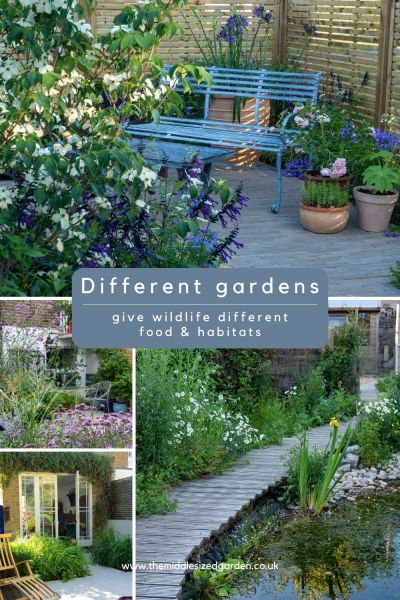
If a town has a wide variety of different gardens, it can mimic the variety of habitats and food sources in the countryside – if you follow a few basic rules.
The basic rules to improve your garden’s eco-system
The first and most important rule is not to use insectides or herbicides, says Fergus. They will kill the good things in your garden as well as the bad ones.
‘When we first stopped spraying, we thought we’d get over-run with pests in the first year,’ he explains. ‘But apart from some aphid infestations, that didn’t happen.’
This ties in with what Neil Miller at Hever Castle says about roses. In Growing Roses he says that the roses are covered with aphids in early June. But they don’t spray and two weeks later, the birds and ladybirds have eaten almost all of them.
Even if insecticide sprays don’t actually harm other wildlife, you’re still taking away a food source by killing some insects artificially. Less food means fewer predators. So when the pest insects come back (and they always do), there won’t be so many predators waiting to gobble them up.
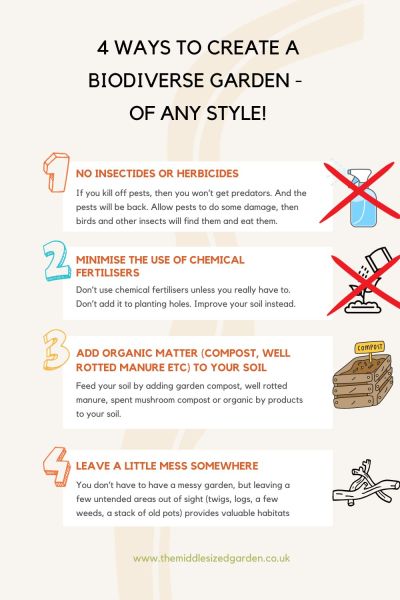
Any style of garden can be biodiverse if you follow a few simple rules.
Do I really need to use fertilisers?
You don’t need to use fertilisers if you do two things. Firstly, enrich your soil by applying a layer of organic mulch (such as garden compost, well rotted manure or organic mulch by-products) at least once a year.
Secondly, choose plants which grow well in your climate and soil. ‘Right plant, right place,’ says Fergus.
They’ve stopped using chemical fertilisers at Great Dixter. ‘We used to use Growmore, then we tried Fish, Blood & Bone. We stopped using fertilisers at all a few years ago, and it didn’t seem to make any difference,’ he says.
The gardens are packed with plants with abundant flowers.
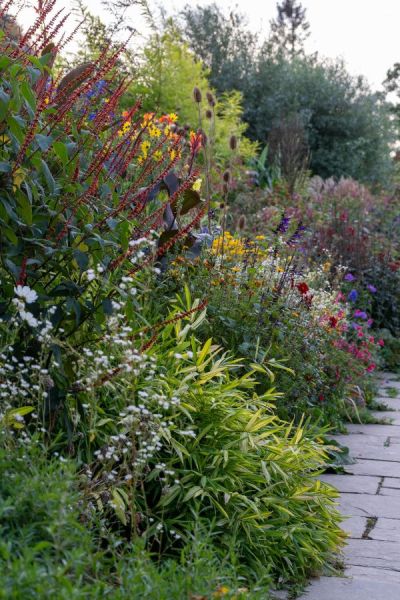
They don’t use any chemical fertilisers at Great Dixter, but the borders are full of flowers. ‘We didn’t notice any difference when we stopped using it,’ says Fergus.
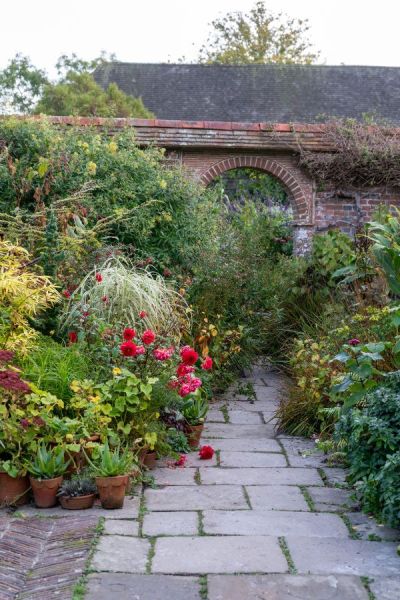
Even flowers in pots are valuable to pollinators and wildlife. This is the entrance to the Barn Garden at Great Dixter. The lichens on the brick wall and the growth between the pavers adds to the mellow atmosphere of an old garden – and also benefits the environment.
Compost, mulch and watering
These three are tied together, because if you get compost and mulching right, you won’t need to water as much.
At Great Dixter they make some of their own garden compost, ‘but it’s never enough,’ says Fergus.
I agree, I think it’s extremely difficult for any garden of any size to make as much compost as it needs. Find out how to make compost the easy way here. But, as in Great Dixter, you’ll almost definitely have to go out and buy something.
Fergus uses an organic waste by-product from a local energy company.
It will take a bit of research to find one for your garden, but start by searching for ‘organic byproduct mulch for sale’. He previously used spent mushroom compost, but the local mushroom farms closed down and he discovered that the spent mushroom compost was being transported long distances by lorry.
Bark chips are a good byproduct of the timber industry, but they usually need to rot down more before they’re added to garden borders.
‘And if I didn’t have anything else, I’d use garden manure,’ says Fergus. The disadvantage of manure is that it can have weed seeds in it, or a chemical called aminopyralids.
These mulches have two functions. Firstly, they break down to feed the soil. Secondly, they create a layer on top of the soil to stop water evaporating, so you need to water less.
What about weeding? Do you have to leave weeds in order to be wildlife friendly?
There is now a much more relaxed approach to weeding in gardens. But we all still weed, and Great Dixter is no exception.
‘We do weed,’ says Fergus. He’s allowed a few plants that are considered ‘weeds’ to creep into the borders, but only because he likes the look of them. That’s cow parsley, buttercups and dandelions. ‘One person’s weed is another person’s perfectly good garden plant.’
Otherwise they hand weed, because weed-killers also have a negative effect on the environment.
But the main anti-weed policy is to keep the borders crammed so full of plants that the weeds have less chance to grow.
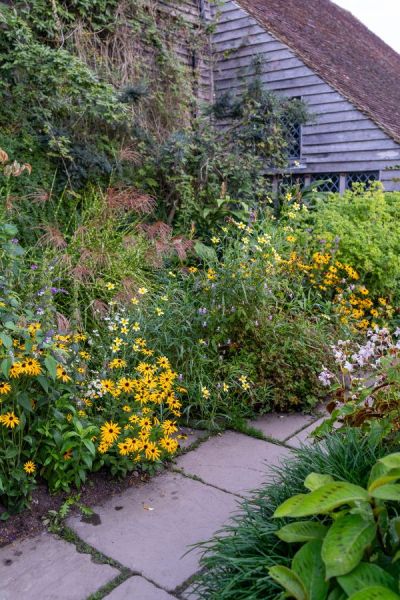
The Barn Garden is packed with flowers and plants, so they don’t have to weed often.
The secret of minimal watering
Even in the heat and drought of 2022, the Long Border at Great Dixter was only watered four times. But it was watered very, very thoroughly.
The key is to make sure plants develop a healthy network of roots that seek out water deep in the soil. If you water little and often, the water will stay on the surface so the plant roots will too.
At Great Dixter they use a very low sprinkler that only trickles water across the surface, not spraying it up in the air. They set it down in an area and let the water seep out for around two hours. Then they move it to the next part of the border.
The result is that the water penetrates slowly, down to where it’s needed.
They also water very thoroughly when they plant the plant, surrounding it with a layer of mulch.
You can find out more about how to plant a plant like this in Steven Edney’s advice on Brilliant Border Maintenance here.
Is a lawn bad for the environment?
You may have read reports that lawns are bad for the environment. But if you read those reports closely, you’ll see that they are based on research done in ‘arid parts of the United States.’ Phrases like ‘green desert’ are used.
However, in the UK and many other countries, lawns are mainly based on native grasses. They are rarely, if ever, watered. Lawns like those at Great Dixter are not sprayed or fertilised.
Lawns absorb heat, give out oxygen and support wildlife. You can read more about lawns and sustainability in Do You Need A Perfect Lawn? ‘
At Great Dixter, they have short lawns, longer lawns, meadow areas and areas of rough grass. ‘We mow erratically,’ says Fergus. ‘And people mow erratically.’ All these areas support biodiversity.
A few years ago, I started growing the grass in my front garden long, as a ‘mini-meadow’. I knew I had a colony of ivy mining bees living there. They live underground and emerge in September, before going back underground again. But when I started to grow my front garden grass long, the ivy mining bees almost seemed to disappear.
Now I leave the grass long from January to July, then keep it short until December. And the ivy mining bees are back in a big way. I asked the Great Dixter ecologist about this. He said that these bees need access to the soil. So they need short grass.
Plants, flowers, lichens, algae & mosses – they all support wildlife
Fergus doesn’t specifically choose plants that support wildlife, because the garden is large enough to have lots of everything. ‘If you had a smaller garden, it would be good to choose more pollinator friendly plants, such as alliums,’ he says.
It’s also worth remembering that although some plants are better for pollinators than others, many plants offer other benefits. In Gardening for Biodiversity Helen Bostock of the RHS says that although her favourite double-flowered roses aren’t good for bees, their leaves are loved by leaf-cutter bees.
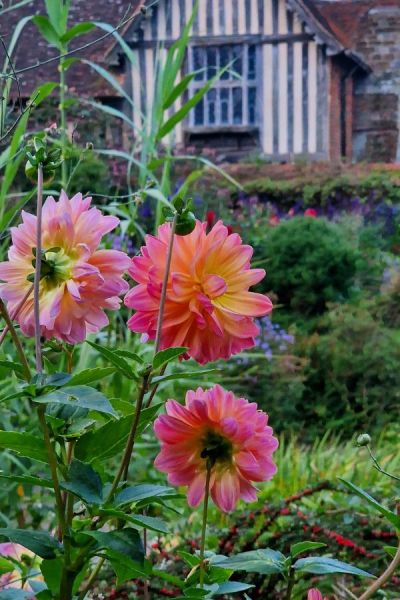
Fergus doesn’t specifically choose plants for their pollinator-friendly flowers, because there’s room for lots of flowers at Great Dixter. If you have a smaller garden, you’d probably want to deliberately choose some pollinator friendly plants, such as alliums.
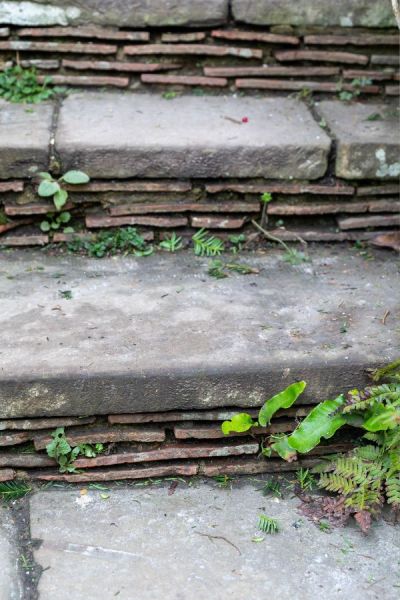
Don’t be too clean and tidy in your garden. Let it show algae and lichen, with plants in nooks and crannies, like these steps at Great Dixter. It looks beautiful and is very good for biodiversity.
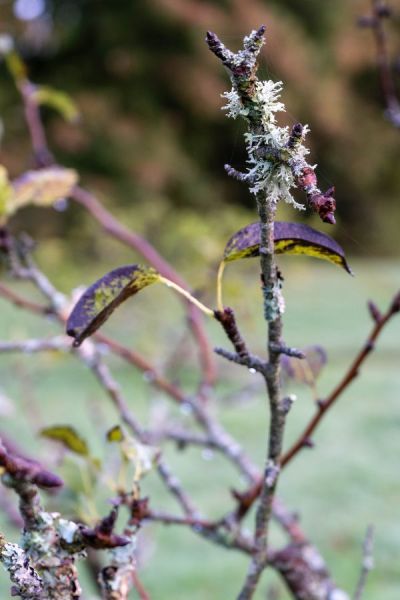
Lichens grow on old branches, but they don’t damage wood. And they’re often a sign that your air is not polluted. At Great Dixter, they don’t cut away dead branches if they’ve got lichen on them.
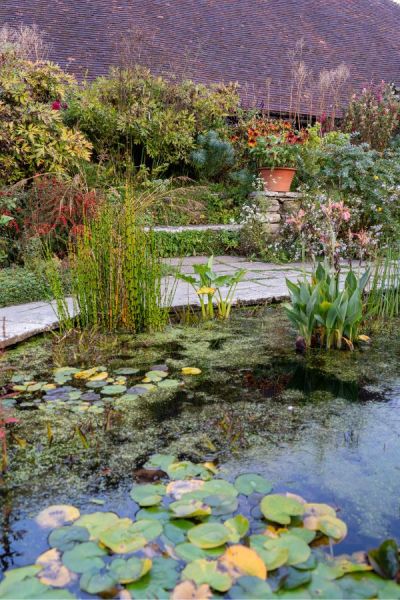
Add water to your garden to support wildlife. The large pond in the Barn Garden has helped make it the most biodiverse part of the Great Dixter estate.
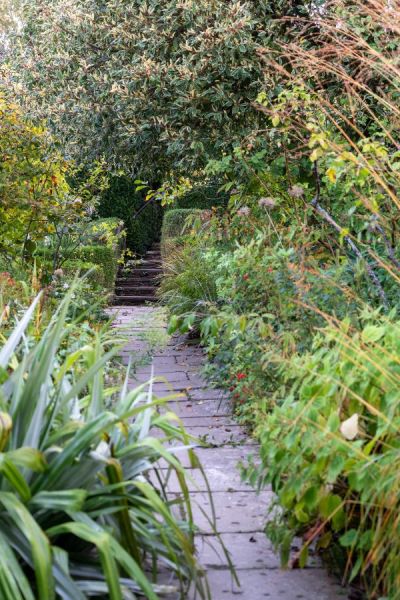
Some parts of the garden are ‘less worked’ than the borders – they’re shrubs and trees that don’t need much attention. But such areas are also valuable for biodiversity.
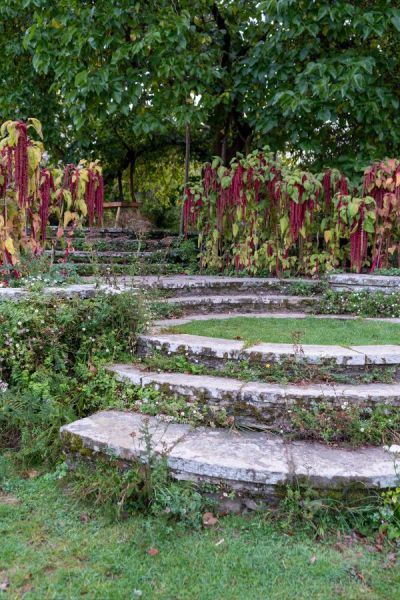
Grow all kinds of plants. Annuals are plants that germinate, flower, set seed and die in one year, so they’re more work but many are very pollinator friendly like these dramatic Amaranth (Amaranthus caudatus) by the steps at Great Dixter
Visit Great Dixter (online or in person)
It’s really worth visiting this wonderful garden if you’re in the Sussex area. (Find visiting times here).
They also run plant fairs twice a year, which attract plant lovers from all over the UK and beyond. Find out what you can expect from the Great Dixter plant fairs here.
And there are online and in person workshops, a Friends scheme and horticultural scholarships too. Many of today’s most famous garden designers and plant experts have spent time learning and working at Great Dixter. We’ve interviewed several on the Middlesized Garden including Tom Coward on the perfect English garden, Michael McCoy on naturalistic planting and Stephen Ryan on cannas and slug-resistant plants.
Looking at the gardens they’ve created proves how different gardens can be, and still support wildlife.
More tips on how to support wildlife
Landscaper and wildlife garden expert Joel Ashton has 5 easy wildlife garden tips here.
And you could go into more detail in What Makes a Good Wildlife Garden.
Wildlife friendly garden tips is the story of how one person turned their long, narrow town garden into what magazines have called ‘the garden of the future, sustainable, all about wildlife and a complete joy.’
Sometimes you can support wildlife by doing less – and that has benefits for you too. For example, fewer people now rake up all their leaves – see leave the leaves to find out which leaves you can safely leave and which ones you really do have to clear away. Leaves that fall in your borders offer shelter for wildlife and decompose to add nutrition to the soil, for example.
Pin to remember how to support wildlife and still have the garden you want!
And do join us. See here for a free weekly email with more gardening tips, ideas and inspiration.
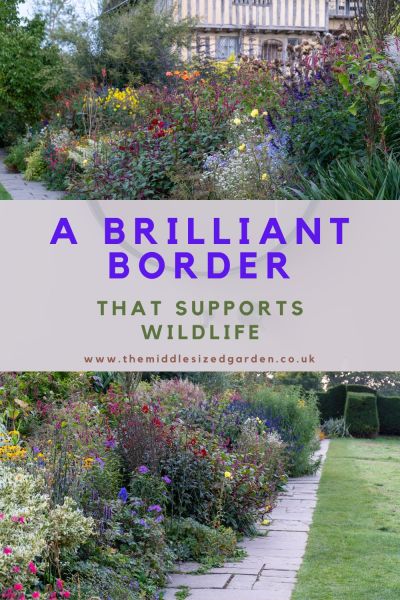
























I love the way this article breaks down the lessons from Great Dixter’s success. It’s not just a garden; it’s a thriving ecosystem where nature and beauty coexist harmoniously. The lessons are like golden nuggets for anyone looking to create a space that supports wildlife and is a visual delight.